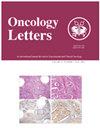原发性吻合血管瘤是腹膜后海绵状血管瘤的术前诊断模拟物:病例报告。
IF 2.2
4区 医学
Q3 ONCOLOGY
引用次数: 0
摘要
吻合血管瘤(AH)很罕见,是一种新发现的毛细血管瘤变种,多见于泌尿生殖道。此外,吻合血管瘤有时在没有病理标本的情况下很难诊断。由于缺乏特异性的临床和影像学表现,术前诊断也很困难。本报告从放射学角度描述了其影像学特征,并概述了临床病理学特征和治疗方案。一名 67 岁的女性因在 4 年前的体检中发现腹膜后肿瘤而被转诊至独协医科大学埼玉医疗中心(日本越谷市)。患者无任何症状,无异常体征,无既往病史或特殊家族史。血常规检查结果均在正常范围内。非增强CT扫描显示,腹膜后肿瘤呈圆形,大小约为32×23毫米,位于腹主动脉和下腔静脉之间,左肾静脉下方。在造影剂增强多切面 CT 扫描中,肿瘤在动脉期显示异质间隔强化,在门脉期显示持续强化。当时该肿瘤被诊断为良性神经源性肿瘤或腹膜后海绵状血管瘤,患者本打算在门诊进行随访。然而,在 4 年的时间里,肿瘤逐渐增大,最大直径达到 35 毫米。最后,通过开腹手术将其完全切除,病理诊断为 AH。腹膜后血管瘤在成年期极为罕见,仅占所有腹膜后肿瘤的 1-3%。据我们所知,目前仅有 6 例主动脉旁 AH 的报道。这种变异的发病率非常低。不过,当主动脉旁区域出现缓慢进展的异型肿块,且其 CT 增强形态与典型的海绵状血管瘤相似时,可将 AH 纳入鉴别诊断。本文章由计算机程序翻译,如有差异,请以英文原文为准。
Primary anastomosing hemangioma as a preoperative diagnostic mimicker of retroperitoneal cavernous hemangioma: A case report.
Anastomosing hemangioma (AH) is rare and a newly recognized variant of capillary hemangioma that is mostly found in the genitourinary tract. Additionally, AH is sometimes difficult to diagnose without pathological specimens. It is difficult to diagnose preoperatively due to the lack of specific clinical and radiologic appearance. The present report describes the imaging features from a radiological perspective and outlines the clinicopathologic features and treatment options. A 67-year-old woman was referred to Dokkyo Medical University Saitama Medical Center (Koshigaya, Japan) for a retroperitoneal tumor that was identified at a medical checkup 4 years prior. The patient had no symptoms, no abnormal physical signs and no past medical or specific family history. Routine blood tests were all within the normal ranges. A nonenhanced CT scan showed a circular, homogenous, well-circumscribed retroperitoneal tumor that was ~32×23 mm in size, between the abdominal aorta and the inferior vena cava, and just below the left renal vein. On a contrast-enhanced multidetector CT scan, the tumor showed heterogeneous septal enhancement in the arterial phase and persistent enhancement in the portal phase. The tumor was diagnosed as a benign neurogenic tumor or a retroperitoneal cavernous hemangioma at the time, and the patient was intended to be followed up at the outpatient clinic. However, it gradually increased to a maximum diameter of 35 mm over 4 years. Finally, it was completely resected by open laparotomy and pathologically diagnosed as AH. Retroperitoneal hemangioma is extremely rare in adulthood and has been confirmed in only 1-3% of all retroperitoneal tumors. To the best of our knowledge, only 6 cases of para-aortic AH have been reported. The incidence of this variant is very low. However, AH may be included in the differential diagnosis when a slowly progressing heterogeneous mass appears in the para-aortic region that exhibits a CT-enhanced pattern similar to a typical cavernous hemangioma.
求助全文
通过发布文献求助,成功后即可免费获取论文全文。
去求助
来源期刊

Oncology Letters
ONCOLOGY-
CiteScore
5.70
自引率
0.00%
发文量
412
审稿时长
2.0 months
期刊介绍:
Oncology Letters is a monthly, peer-reviewed journal, available in print and online, that focuses on all aspects of clinical oncology, as well as in vitro and in vivo experimental model systems relevant to the mechanisms of disease.
The principal aim of Oncology Letters is to provide the prompt publication of original studies of high quality that pertain to clinical oncology, chemotherapy, oncogenes, carcinogenesis, metastasis, epidemiology and viral oncology in the form of original research, reviews and case reports.
 求助内容:
求助内容: 应助结果提醒方式:
应助结果提醒方式:


